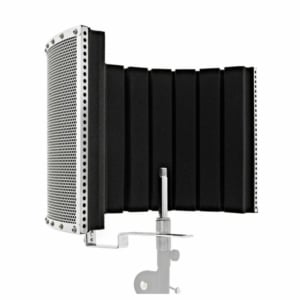Microphone Shields
Showing the single result
A microphone reflection filter is a device used in audio recording to reduce the impact of the acoustics of the room on the sound captured by the microphone. It’s essentially a portable device that is positioned behind a microphone to control and limit the amount of direct sound that reaches the microphone from its surrounding environment.
The reflection filter acts as a kind of mini vocal booth, absorbing and diffusing the sound waves that come towards the microphone from its rear and sides. This helps to prevent the echo or reverb of the room from being picked up by the microphone, leading to a cleaner and clearer recording, especially in home studios or less-than-ideal recording environments.
The filter is typically made of acoustic foam or similar materials that are good at absorbing sound, and is often curved or semi-circular in shape to better control the sound waves. It’s an essential piece of equipment for any recording setup, particularly if you’re trying to achieve professional-level sound in a non-professional environment.
Microphone shields (or reflection filters) are beneficial in a variety of recording environments, but they are especially useful in the following situations:
- Home Studios: These environments often lack professional acoustic treatment. The shield can reduce the impact of room noise and reverb, helping to capture cleaner and clearer recordings.
- Untreated Spaces: This could include rooms with hard surfaces, like tiled floors, bare walls, or large windows, which can create echo and unwanted reflections. A microphone shield can help to minimize these issues.
- On-Location Recordings: If you’re recording in an environment that isn’t designed for recording, such as a hall, a room in a house, or outdoors, a microphone shield can help to improve sound quality by reducing background noise and reflections.
- Small Rooms or Booths: In such environments, sound tends to bounce back quickly, which can lead to a boxy or echoey sound. A shield can help to minimize this.
- Multipurpose Spaces: If you’re recording in a space that also serves other functions (like a living room or a bedroom), a portable microphone shield can provide a quick and easy way to improve the recording conditions without needing to permanently alter the room.
It’s important to note, however, that while a microphone shield can improve recording quality in these situations, it can’t completely substitute for professional acoustic treatment if you’re seeking the highest possible sound quality. If possible, consider combining the use of a shield with other forms of acoustic treatment for the best results.
While microphone shields (or reflection filters) offer many benefits, there are a few potential downsides to consider:
- Incomplete Isolation: A shield can’t provide complete sound isolation. It will primarily reduce reflections from the rear and sides of the microphone, but it won’t fully prevent sound from entering the microphone from the front or from echoing off the ceiling or floor.
- Limited Effectiveness with Low Frequencies: These devices are more effective at controlling mid and high frequencies. Low-frequency sounds (like the rumble from traffic or air conditioning) can still get through, as these sounds are more difficult to absorb.
- Potential Coloration of Sound: Depending on the design and material of the shield, it may slightly color the sound of the recording. For example, if the shield is too close to the microphone, it might create a small resonant chamber that could affect the sound.
- Portability and Size: While shields are more portable than full-size vocal booths, they can still be somewhat bulky and heavy. This might be an issue if you’re traveling with your recording equipment, or if your recording space is limited.
- Cost: While they’re less expensive than a full vocal booth or extensive acoustic treatment, microphone shields can still represent a significant investment, especially if you’re on a tight budget.
- Dependency: Some users might become overly dependent on the shields, neglecting other important aspects of room treatment and microphone technique that could also greatly improve their recording quality.
Despite these potential downsides, many people find that the benefits of using a microphone shield outweigh the drawbacks, especially when recording in less-than-ideal environments.

